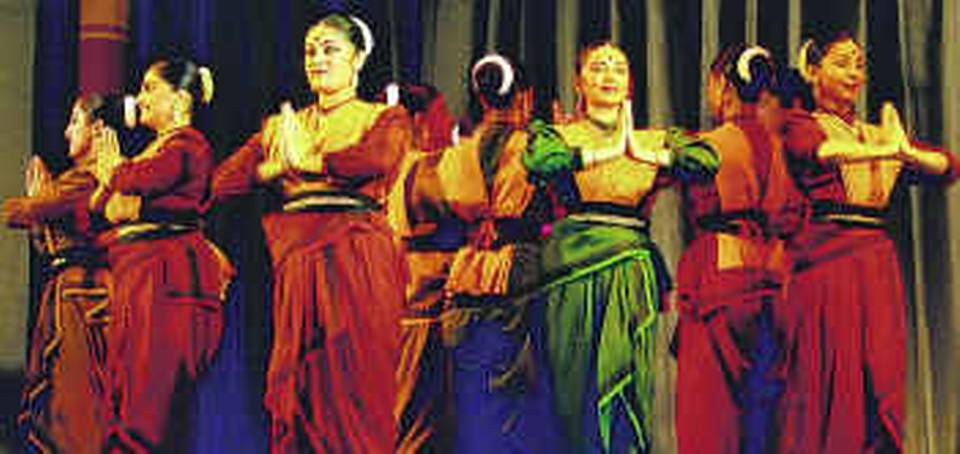'Satyam Shivam Sundaram' was a well-choreographed piece that seamlessly combined nritta and nritya

VISUAL HARMONY: 'Satyam Shivam Sundaram'
amalgamated dance forms to convey the essence of the theme
amalgamated dance forms to convey the essence of the theme
Aesthetic thematic interpretation
By Harish Bal The Hindu, Online edition of India's National Newspaper Entertainment Thiruvananthapuram, Friday, Jan 06, 2006"Truth that is auspicious and beautiful is enshrined within creation." This dictum forms the foundation for 'Satyam Shivam Sundaram,' a production by Dhananjayan and Shanta for Bharata Kalanjali and Fine Arts Society, Yogaville. A tribute to Swami Satchidananda Maharaj, the production featured as the first annual programme of Dharani Society, Kochi.
A 12-member troupe of the Dhananjayan's disciples from the United States performed this piece. The opening scene titled 'The Lotus,' symbolised beauty that is knowledge. In a poem by Muthukannappar, the dancers sketched the abstractness of beauty through the many petals of the lotus. The fragrance of the flowers attracts bees, like the true seekers of knowledge.
In the next scene, the dancers traced the vibrancy of the five life forces of earth, water, fire, air and ether. The serenity of earth and water contrasted brilliantly with the flare of fire in the expressions and movements of the dancers. These forces emanate from the Mother Goddess of everlasting energy. This energy was depicted in the evolution of the three goddesses, Vani, Lakshmi and Parvati in a poem by Bharathiyar. These were interspersed with jathis that were snippets of masterly choreography.
Pure dance sequences
The production liberally amalgamated the movements and style of Bharatanatyam, Kathakali, freestyle dance movements and theatre, giving ample importance to pure dance sequences and intricate footwork. The cream of the presentation was Ekam tat viprah bahudha vadanti capturing the myth of King Dharmika. Dharmika leaves his sword, the symbol of power, with a hermit before leaving on a pilgrimage. His ability to understand the language of the animals enables him to live in harmony with nature and truth. He implements the same in his kingdom by giving up the use of power.
Padmarani Rasiah excelled in the role of Dharmika. In an episode with a Chandala, he discovers that the soul is far removed from the clutches of caste and race. This realisation was depicted with subtle nuances of abhinaya by Padmarani whose nritta showed utmost precision and clarity.
The other participants skilfully portrayed the movements of the animals. Kannan Rasiah, the only male dancer, showed great flexibility and felicity of expression in a jugalbandi and the tillana.
Enchanting scene
Another enchanting scene was the depiction of different religions and faiths using props and candle lights. Vaishnavajanatho thene kahiye, which was performed against this background, was a moving experience for the audience.
A thematic interpretation of abstractions as truth and beauty, simplified with relevant anecdotes and myths with great clarity, well rounded by magical choreographic moments made 'Satyam Shivam Sundaram,' a captivating experience.
